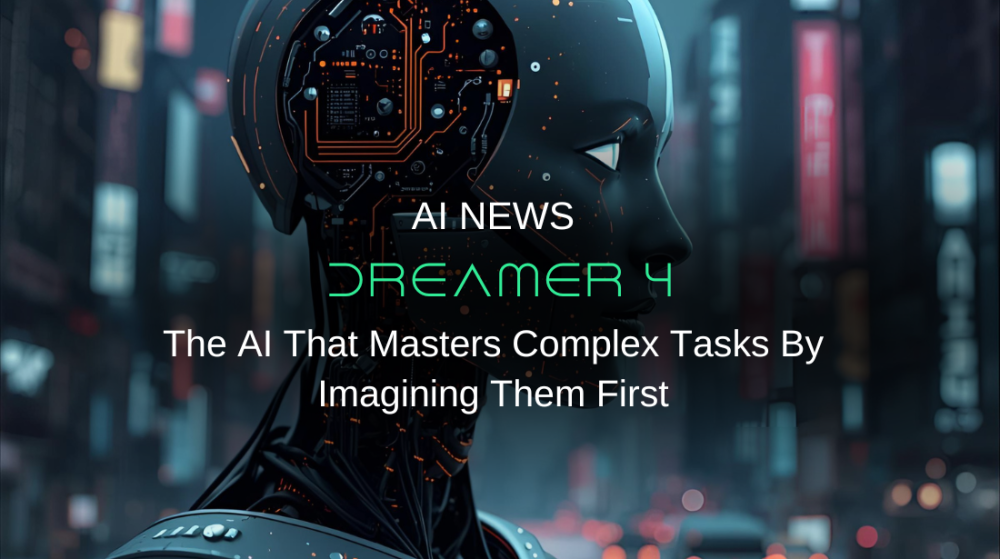Dreamer 4: The AI That Masters Complex Tasks By Imagining Them First
Imagine learning to play a complex video game or control a robot without ever actually touching it. That's exactly what Dreamer 4, a groundbreaking artificial intelligence system, can do. Announced in September 2025 by researchers Danijar Hafner and Wilson Yan, this revolutionary AI learns entirely in its imagination, and it's changing how we think about machine learning.
What Is Dreamer 4?
Dreamer 4 is an AI agent that learns to perform complicated tasks by building a mental model of the world and practicing inside that model. Think of it like a chess player visualizing moves in their head before touching a piece. Instead of learning through endless trial and error in the real world, Dreamer 4 creates a virtual simulation in its "mind" and trains there instead.
This approach is called "world model learning," and Dreamer 4 takes it to an entirely new level of sophistication and speed.
The Minecraft Breakthrough: Learning From Watching, Not Doing
One of Dreamer 4's most impressive achievements is mastering Minecraft—specifically, learning to collect diamonds, one of the game's most challenging goals. What makes this extraordinary is that Dreamer 4 accomplished this feat using only offline data. It never actually played the game during training.
To put this in perspective, collecting diamonds in Minecraft requires a player to execute over 20,000 precise mouse and keyboard actions in the right sequence. The AI had to learn everything from raw pixels, understanding game mechanics, object interactions, crafting recipes, and strategic decision-making, all without a single practice run.
Dreamer 4 is the first AI system to achieve this purely from offline learning, making it a major milestone in artificial intelligence research.
How Does Dreamer 4 Work?
Building a Mental Simulator
Dreamer 4 works in three main steps:
- Learning the World Model: The AI watches videos and observes data to build an internal simulation of how the world works—understanding physics, object interactions, and cause-and-effect relationships.
- Imagination Training: Instead of practicing in the real environment, Dreamer 4 trains inside its mental simulation, trying out thousands of different strategies and learning from imagined outcomes.
- Applying Knowledge: When it's time to perform in the real world (or real game), Dreamer 4 applies everything it learned in imagination.
Learning From Unlabeled Videos
One of Dreamer 4's smartest features is its ability to learn from unlabeled video data. It can watch massive amounts of video footage to understand general patterns and behaviors, then fine-tune specific actions using only a small amount of labeled training data. This makes the learning process far more efficient than traditional methods.
Real-Time Performance on a Single GPU
Despite its advanced capabilities, Dreamer 4 can run in real-time on just one GPU (graphics processing unit). This efficiency comes from a clever new architecture that allows the AI to simulate complex scenarios quickly without needing massive computing power.
Why Dreamer 4 Matters: Real-World Applications
Safer Robot Training
Training robots in the real world can be expensive, time-consuming, and even dangerous. With Dreamer 4's approach, robots could learn complex tasks like assembly, navigation, or manipulation entirely in simulation, then transfer that knowledge to the physical world. This dramatically reduces the risk of damage and speeds up the development process.
Autonomous Systems
Self-driving cars, drones, and other autonomous systems could benefit from Dreamer 4's imagination-based learning. Instead of requiring millions of miles of real-world driving data, these systems could learn to handle rare and dangerous scenarios in simulation first.
Cost-Effective AI Development
Traditional reinforcement learning requires agents to interact with their environment millions of times, which is resource-intensive. Dreamer 4's offline learning approach reduces costs and speeds up development timelines significantly.
The Evolution of Dreamer: Building on Success
Dreamer 4 is the latest in a series of increasingly capable AI systems:
- Dreamer (2020): Introduced the concept of learning behaviors by imagining future scenarios
- DreamerV2: Expanded capabilities to more complex games and tasks
- DreamerV3 (2025): Published in Nature, became the first AI to collect diamonds in Minecraft without human guidance
- Dreamer 4 (2025): Achieves the same feat using only offline data, without any environment interaction
Each generation has pushed the boundaries of what's possible with world model learning.
Interactive World Models: A New Frontier
Dreamer 4's world model is so accurate that human players can actually interact with it in real-time, demonstrating how well the AI understands complex environments. The system can generate realistic, interactive scenarios that respond naturally to actions, showing a deep comprehension of game mechanics and object physics.
What Makes Dreamer 4 Different From Other AI?
Most AI systems learn through one of two approaches:
- Model-free learning: Learning directly from experience through trial and error (like reinforcement learning)
- Supervised learning: Learning from labeled examples provided by humans
Dreamer 4 uses a third approach: model-based learning with imagination. It builds an internal understanding of how the world works, then uses that understanding to practice and improve without needing constant real-world interaction.
This approach combines the best of both worlds, the flexibility of reinforcement learning with the efficiency of learning from observation.





